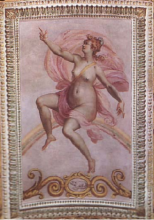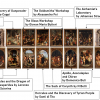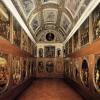
Studiolo of Francesco I: Structure
Commentary
The decoration of the Studiolo was the responsibility of Giorgio Vasari (1511-1574). However, for the design (invenzione), Vasari appealed to Vincenzo Borghini (1515-1580), Cosimo I’s lieutenant of the newly founded Accademia delle Arti del Disegno, the first ever artist academy.
Borghini conceived the plan for the Studiolo in autumn 1570. By then some aspects of the Studiolo were already designed, such as the commission of 8 statues and the general structure of the ceiling. Yet it was Borghini who came up with the coherent structure that transformed the Studiolo in a representation of a microcosm of the wider world.
At the core of Borghini's programme was the relationship between Nature and Art. He saw them as being closely supportive of each other, and put this view at the centre of the Studiolo, in the middle of the ceiling:
in the central tondo [round area] we will depict Nature, which would have in company her Prometheus, the first inventor of the precious stones and of rings, as Pliny [i.e. the Elder] has witnessed (887).
The fresco was done by Francesco Morandini, surnamed il Poppi, and portrays a seated Prometheus, unbound and holding the fire stalk he stole from the gods according to ancient mythology. He is stretching his hand to take an unformed diamond from a couched Nature, which he will in turn perfect by his labour and the aid of fire.
Borghini described the ceiling as the 'sky' and further divided it in four, according to the four elements:
Because Nature has the subject of its operations and effects primarily the four elements, of which two are as the body and the matter of these things, and these are earth and water, the other serving for efficient [causes] and operators, that is, the air and especially fire... and accommodating the nature of things to the quality of these elements the most gently that is possible... we would adorn the room with a variety of figures of all ages, sexes, qualities and proportions, so that art and artifice would be able to demonstrate the ingenious nature of inventions and the industry of the hands. (887)
Borghini further assigned the directions, and each element was depicted on the ceiling by an allegorical female figure. The figure of Air, for instance, is a woman with flowing robes, seated on a rainbow, and pointing with her fingers up and down, as a means of suggesting its connecting role between the upper and lower worlds.
The Air element was assigned to the West of the Studiolo, and the entire Western wall was dedicated to it. Two statues, placed in spaces at the corners of the wall, were to 'govern' each element. The two statues of the Air element were Juno, which Borghini saw as the ruler of the air and the governor of matrimony, and Boreas, the god of the northern wind. These choices were not random and were in fact closely linked with Francesco's prized collection: Juno was seen as being connected with jewelry and precious stones like diamonds which can be displayed on rings, while Boreas was connected with crystals, 'which congeal due to great cold' (887). The statues were made by Giovanni Bandini (Juno) and Elia Candido (Boreas).
In between the statues were placed one or more rectangular paintings (in the case of Air there is only one, but the long Fire wall, for instance, has six paintings). Just below the statues and the paintings, oval paintings were commissioned. The ovals are actually doors leading to cupboards containing Francesco’s collected objects, divided themselves amongst the elements. Thus the statue or rectangular painting, with the oval below and the objects formed a logical threefold continuum. An example is 'pearls' which is made up of Alessandro Allori's Pearl Fishing rectangular painting and his Cleopatra's Banquet (which is a reference to Cleopatra's gesture of melting her pearl earring in a cup of vinegar and drinking it at a banquet for Mark Anthony).
Unfortunately, the dismantling of the Studiolo in the late 17th century (mentioned in the Introduction) means that the threefold structure is not always evident today. The 1910 reconstruction of Giovanni Poggi and Alfredo Lensi was based on a few documents and rushed-up conclusions, with the result that the existing setup is in some cases clearly erroneous. Although more documents clarifying the structure have emerged in the late 20th century, the Studiolo has not been changed.
Commentary and Translations: Georgiana Hedesan (January 2022).


